Staver
The Staver and Staver-Chicago was an American Brass Era automobile manufactured at 76th and Wallace Streets in Chicago, Illinois, by the Staver Carriage Company from 1906 until 1914.[1][2]
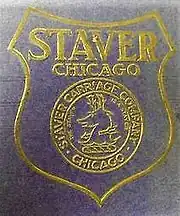 1912 Staver-Chicago emblem from brochure | |
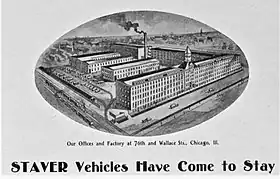 Staver factory in 1905 from advertisement | |
| Industry | Coachbuilder, Automotive |
|---|---|
| Founded | 1899 |
| Founder | Henry C. Staver |
| Defunct | 1914 |
| Fate | Closed |
| Headquarters | Chicago, Illinois, |
Key people | Henry C. Staver, Harry B. Staver, Dan C. Teetor |
| Products | automobiles |
Production output | 7,092 (1906-1914) |
History
Staver Carriage Company was organized after the 1896 bankruptcy of the Staver-Abbott Carriage Company, by Henry C. Staver in 1899. In 1905 Staver began an expansion of their carriage factory and also began developing a high-wheel automobile that would be introduced in late 1906. Henry C. Staver died in 1907 and his son Harry B. Staver became president of Staver Carriage Company.[3][4][5]
The company's initial Staver automobile was an 18/20-hp high wheeler, with a stanhope body. Larger, more powerful and more expensive at $1,000 (equivalent to $31,407 in 2022) than most high-wheelers, it was fully equipped with top, side curtains, storm front, lights and toolbox. As Models C and D, it debuted at the 1907 Chicago Auto Show and approximately 200 were sold into 1908.[6][7][8]
Production was turned over to conventional automobiles with a two-cylinder 20-hp roadster in 1909 and four-cylinder models beginning in 1910.[1] Staver purchased 500 American & British Manufacturing Company four-cylinder engines designed by Charles F. Herreshoff. Poor manufacturing resulted in a lawsuit that lasted until 1914.[9] Teetor engines from the Light Inspection Car Company designed for Staver, were used from 1910. In 1912, Dan C. Teetor became chief designer for Staver until 1914.[4]
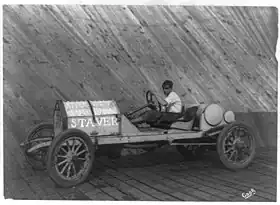
With the introduction of the 4-cylinder automobiles, Staver's were advertised as Staver-Chicago models.[10] Staver became very active in motorsports and reliability runs and participated in the Elgin National Road Races, Algonquin Hill Climb, Chicago's 1,400 mile Reliability Run, many board races and culminating in the Around Lake Michigan runs in 1911 and 1912. Gus Monckmeier, Chester Cheney, Emery Knudsen, Harry L. Curran and Ralph Ireland were all drivers for Staver. Ralph Ireland died in a practice run when his Staver-Chicago burst a tire at Elgin.[11][12][13][14] Munckmeier had a perfect score for Staver in the 1911 Around Lake Michigan trial, but was later suspended along with Staver from AAA events for a year, when it was found the winning Staver-Chicago car was not stock.[15]
For 1912 Staver-Chicago was dropped and all cars were again advertised as Staver.[16] Staver's were mid-priced in the $1,650 to $2,250 (equivalent to $68,229 in 2022) range with limousines priced up to $3,500.[1]
1914 Models were introduced early in March 1913 and included the new six-cylinder Staver of 70-hp, priced as a touring car at $2,750, equivalent to $80,344 in 2022.[15][1] Production for cars ended in June 1914, and carriages later in the year.[1] Staver Carriage Company continued as a property company for a few years, leasing the Staver factory to Partin Manufacturing Company and other automobile manufacturers.[1] The factory and automobile equipment transferred to Studebaker in 1917 in a property swap.[17]
Models
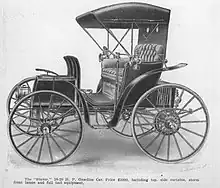 1906 Staver 18/20-hp Model D
1906 Staver 18/20-hp Model D 1911 Staver-Chicago 30-hp Model T
1911 Staver-Chicago 30-hp Model T 1913 Staver 35-hp Inglewood Touring Car
1913 Staver 35-hp Inglewood Touring Car 1914 Staver 70-hp Model 65 Touring car
1914 Staver 70-hp Model 65 Touring car
| Year | model | style | cylinder | Power (hp) | Wheelbase (in) | Body |
|---|---|---|---|---|---|---|
| 1907-1908 | Model D | 2 | 18/20 | 78 | Stanhope buggy 2 seater | |
| 1909 | Style 20 | 2 | 24 | 86 | Runabout 2-seater | |
| 1910 | 30 HP | Model H | 4 | 30 | 112 | Touring car 5-seater |
| 1910 | 30 HP | Model I | 4 | 30 | 112 | Torpedo 5 seater |
| 1910 | 30 HP | Model J | 4 | 30 | 112 | Surrey 4 seater |
| 1910 | 30 HP | Model K | 4 | 30 | 112 | Baby tonneau 4-seater |
| 1910 | 45 HP | Model L | 4 | 45 | 116 | runabout |
| 1910 | 45 HP | Model M | 4 | 45 | 117 | touring car |
| 1911 | 30 HP | Model B | 4 | 30 | 112 | Baby tonneau 4-seater |
| 1911 | 30 HP | Model F | 4 | 30 | 112 | Fore-Door Touring Car 5 seater |
| 1911 | 30 HP | Model R | 4 | 30 | 112 | Torpedo Roadster 5 seater |
| 1911 | 30 HP | Model RR | 4 | 30 | 112 | Racing roadster 2 seater |
| 1911 | 30 HP | Model T | 4 | 30 | 112 | Touring car 5-seater |
| 1911 | 35 HP | Model I | 4 | 35 | 112 | roadster |
| 1911 | 35 HP | Model I | 4 | 35 | 117 | 5-seater touring car, 5-seater fore-door touring car |
| 1911 | 40 HP | Model R | 4 | 40 | 124 | 7-seater touring car, 7-seater fore-door touring car, coupé , sedan |
| 1912 | 35 HP | Model B | 4 | 35 | 112 | Fore-Door Touring Car 5 seater |
| 1912 | 35 HP | Model B.T | 4 | 35 | 112 | Baby tonneau 4-seater |
| 1912 | 35 HP | Model C | 4 | 35 | 112 | Coupe |
| 1912 | 35 HP | Model D | 4 | 35 | 112 | limousine |
| 1912 | 35 HP | Model F | 4 | 35 | 120 | Fore-Door Touring Car, Special |
| 1912 | 35 HP | Model R | 4 | 35 | 112 | Torpedo Roadster 5 seats |
| 1912 | 35 HP | Model RR | 4 | 35 | 112 | Racing roadster 2 seater |
| 1912 | 40 HP | Model F | 4 | 40 | 124 | Fore Door Touring Car |
| 1912 | 40 HP | Model L | 4 | 40 | 124 | limousine |
| 1912 | 40 HP | Model RR | 4 | 40 | 124 | Racing roadster 2 seater |
| 1912 | 40 HP | Model T | 4 | 40 | 124 | Touring cars 5-seater and 7-seater |
| 1913 | 30 HP | 4 | 30 | 120 | Algonquin Speed Roadster | |
| 1913 | 35 HP | 4 | 35 | 124 | Englewood Touring Car 5-seat, Englewood Limited Touring Car 5-seat, Edgewater Touring Car 5-seat, Newport Touring Car 5-seat, Greyhound Speed Roadster 4-seat, Beverly Touring Car 5-seat, Berkley Tonneau 4-seat, Lakeport Roadster, South Shore Colonial Coupe, North Shore Sedan | |
| 1913 | 40 HP | 4 | 40 | 124 | Dictator touring car 5-seater | |
| 1914 | 45 HP | Model 45 | 4 | 45 | 118 | 5-seater touring car, 2-seater roadster |
| 1914 | 55 HP | Model 55 | 4 | 55 | 120 | Touring car 5-seater, Speedster 2-seater |
| 1914 | 65 HP | Model 65 | 6 | 70 | 138 | Touring cars 5-seater and 7-seater |
Production
Production figures total 7,092 vehicles.[1]
| Year | production |
|---|---|
| 1907 | 213 |
| 1908 | 374 |
| 1909 | 426 |
| 1910 | 816 |
| 1911 | 1,110 |
| 1912 | 1,316 |
| 1913 | 1,410 |
| 1914 | 1,427 |
| total | 7,092 |
About five Staver vehicles still exist.
Advertisements
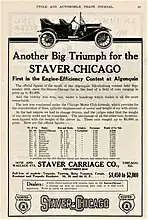 1910 Staver-Chicago advertisement in Cycle and Automobile Trade Journal
1910 Staver-Chicago advertisement in Cycle and Automobile Trade Journal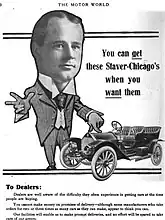 1911 Staver-Chicago advertisement with Harry B. Staver in Motor World
1911 Staver-Chicago advertisement with Harry B. Staver in Motor World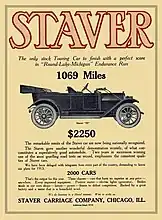 1912 Staver advertisement in Motor Field
1912 Staver advertisement in Motor Field
References
- Kimes, Beverly Rae; Clark Jr., Henry Austin (1996). Standard Catalog of American Cars 1805-1942 (3rd ed.). Krause Publications. ISBN 978-0-87341-428-9.
- Georgano, Nick (2001). The Beaulieu Encyclopedia of the Automobile (3 vol. ed.). Fitzroy Dearborn Publishers. ISBN 1-57958-293-1.
- The Hub. Trade News Publishing Company. 1905.
- Adolphus, David Traver (September 23, 2018). "The Staver Carriage Company". www.hemmings.com. Retrieved 2022-11-23.
- The American Vehicle. Chas. B. Sherron. 1907.
- Automobile Trade Journal and Motor Age. Chilton Company. 1906.
- The Automobile. Chilton Company. 1907.
- Motor. Hearst Corporation. 1907.
- Court, Illinois Appellate (1915). Official Illinois Appellate Court Reports. Legal Division, Pantagraph Printing.
- The Motor World. Motor World Publishing Company. 1910.
- The Automobile. Class Journal Company. 1910.
- The Motor World. Motor World Publishing Company. 1910.
- Motor Age. Class Journal Company. 1910.
- Motor World. Chilton Company. 1911.
- Motor World Wholesale. Chilton Company. 1912.
- Cycle and Automobile Trade Journal. Chilton Company. 1912.
- Chicago Commerce. 1916.
External links
- 1909 Staver Model ER RM Southbys
- DPL Digital Collection - Staver Carriage Company
- Hemmings article - The Staver Carriage Company